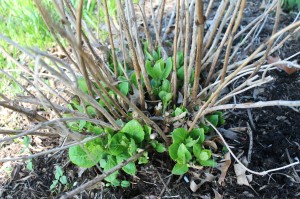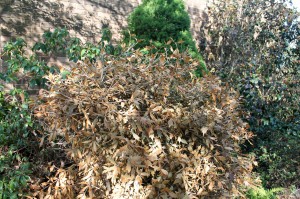Landscape plants suffered worst beating in 25 years
May 23rd, 2014
The verdict is in. The 2013-14 winter was the most plant-damaging one in central Pennsylvania in 25 years.
Ice and wet snow sagged our ubiquitous arborvitae and snapped limbs off most white pines.
A string of frigid winds browned our evergreen leaves and denuded normally winter-hardy azaleas and ivy.
And if that wasn’t bad enough, season-long frozen soil and some of the coldest temperatures in two decades combined to kill borderline-hardy trees and shrubs that had become “safe bets” lately.
“This winter was one of the worst I’ve seen in 25 years for the amount of damage,” said Boiling Springs arborist Eric Vorodi.
“It was a brutal winter,” agreed Jamie Shiffer, the grounds and horticulture operations manager at Hershey Gardens, which lost an array of roses and flowering shrubs. “It’s the worst I’ve seen since I’ve been here, and that’s almost 25 years. We’re still hoping some things will push new growth.”
Landscape evergreens took a particular beating – especially recently planted ones, ones sited in windy areas, ones only marginally winter-hardy to Harrisburg and ones with broad leaves instead of needles.
Among the worst hit: Leyland cypress, cherry laurel, nandina, hardy camellia, mahonia and azalea.
That wasn’t all.
Eric Sweigard of Palmyra lost two 8-year-old rhododendrons and saw a normally evergreen groundcover of ivy go completely brown.
“The rhododendrons went quick, around the end of February,” he says. “My ivy of the past 25-plus years looks like it’s on life support.”
As with most gardeners, Trish Foster of Hummelstown has been waiting to see if her crape myrtle is dead or just killed back to the roots.
“It has a lot of new growth right at the base, but on the older, longer branches… zero,” she says.
That’s been the widespread case with mophead hydrangeas and butterfly bushes – flowering shrubs that weather a usual winter just fine. Most branches this year are dead with new growth emerging from the base or the roots.
For mophead hydrangeas, the dieback likely will mean few or no blooms this season. Butterfly bushes flower on new growth, so they should recover and bloom normally.

This hydrangea has died back nearly to the ground, but it’s still alive. Note the new growth pushing out from the base.
Winter’s wrath went well beyond just the “wimpier” species.
Donna Chamberlain of Pine Grove lost a pair of 5-year-old Hinoki cypresses – a needled evergreen that’s winter-hardy into New England.
Erica Shaffer, manager at Highland Gardens in Lower Allen Twp., lost a pair of Japanese maples that were planted in pots. In the ground, those are hardy to New England, but they weren’t able to survive the more vulnerable above-ground pot setting this winter.
Marcia Drew of Hampden Twp. was surprised that two of her six KNOCK OUT (R) roses are dead to the ground.
Some butterfly bushes are goners, too, not just “top-killed.”
“I’m darned surprised at that one,” says Bob Carey, a Hampden Twp. arborist and host of the Garden Talk radio show on Carlisle’s WIOO-AM. “In a normal season, you can cut a butterfly bush back to nothing, and it comes back.”
Plant experts say the cumulative effect of multiple winter insults are to blame as opposed to any single event.
One factor was the flat-out cold nights.
“We had cold temperature readings in January that we have not experienced in 20 years,” said Annette MaCoy, a Penn State Extension educator in Cumberland County.
She says wind and the root condition of plants also played roles in what lived and what died. Evergreens planted in the past year and ones with weak roots in bad soil generally fared worse, she says.
Highland Gardens’ Shaffer chalks most of the winter woes up to the “ol’ one-two punch” of wind on top of cold.
“I think the sustained winds with extended low temperatures, repeating as the three polar vortices came through, did them in,” she says. “Maybe one of them might have made plants only shiver, but three? That’s agony.”
Vorodi says the long-frozen soil was a particular blow to broadleaf evergreens, such as holly, cherry laurel, azalea and rhododendron.
Broad-leafs continue to lose moisture over winter through their foliage, and when the ground stays frozen for long periods of time, moisture is locked and unavailable for the roots to take up.
“Plants can’t replace the lost water in the foliage,” he explains, and that leads to browning around the leaf edges and then to complete browning, leaf drop and plant death if the “overdrawn” water account gets bad enough.
The good news is that many browned-out or denuded plants are pushing new growth. That’s happening because the branches survived even though the leaves did not.
The weather hasn’t cooperated on that recovery either.
Cold temperatures continued into early spring, and the cool startup delayed recovery by 2 to 3 weeks. It’s only been in the last week or so that some apparently dead plants started poking out new little leaves.
You might want to wait another couple of weeks before ultimately deciding whether to throw in the towel.
Dead wood can be cut off back to live shoots or the whole way back to new basal growth, as in the case of most hydrangeas, butterfly bush and crape myrtles. Check out a related article I did for a case-by-case rundown on what to do about damaged plants.
Plants that are showing no sign of any life by mid-June? Those are probably lost causes.
Brandon Kuykendall, the assistant nursery manager at Ashcombe Farm and Greenhouses in Monroe Twp., says a lot of gardeners apparently aren’t waiting that long.
“Our azaleas are pretty much sold out at this point, and I have a feeling many people wanted to replace ones that lost their leaves over the winter.”
This winter’s experience also has gardeners rethinking whether it’s worth investing in plants that push our winter-cold envelope.
Fare such as nandina, Leyland cypress, crape myrtle, sweetbox, osmanthus and hardy camellia might do fine in 15 straight winters, but when a colder-than-usual one inevitably comes along, they can all die back to the roots or croak altogether.
Says Carey: “Just about the time you go, ‘Yup, this thing is good on its own,’ along comes something like this to whack it.”
“For marginally hardy plants, this is the winter that might have done them in,” adds MaCoy.
Vorodi says some of the decision will boil down to patience.
“Let’s say you have a line of 18- or 20-foot Leyland cypresses and now the outer 6 inches are all brown or dead,” he says. “They might sprout new growth from the interior, but how many people are going to tolerate what they look like in the time it takes for that to happen?”
Answer: Some will, others won’t.
Which is why Vorodi suspects this is going to be a good year for garden centers selling replacement plants.









